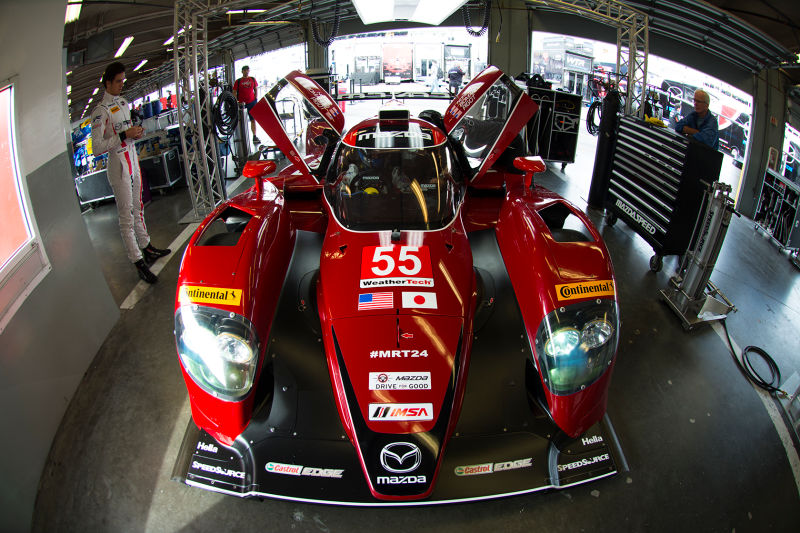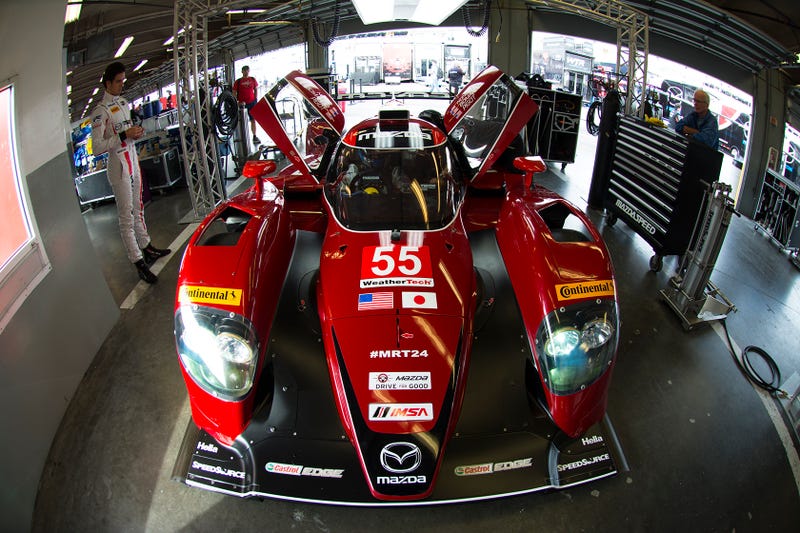
The fancy Mazda Prototype used to be the diesel-powered weirdo of the series now known as the WeatherTech Sports Car Championship, but they had to drop the ability to raise VW owners’ eyebrows for a more conventional powerplant this year. What does the team think of the switch so far? It seems to be working!
http://blackflag.jalopnik.com/bye-bye-diesel…
We picked the brains of the No. 70 car engineering and strategy guru Zach LaGrone before the season started to get his impressions of the new powerplant.
Advertisement
See, we tend to like Mazda’s road cars…a lot. The race cars based on Mazda’s road cars are pretty good. However, Mazda’s flagship endurance racing program hasn’t really seen the same level of success recently. This is the company that gave us the dominant 787B that won Le Mans. It hurts—physically hurts—to see them farting around mid- or back-field.
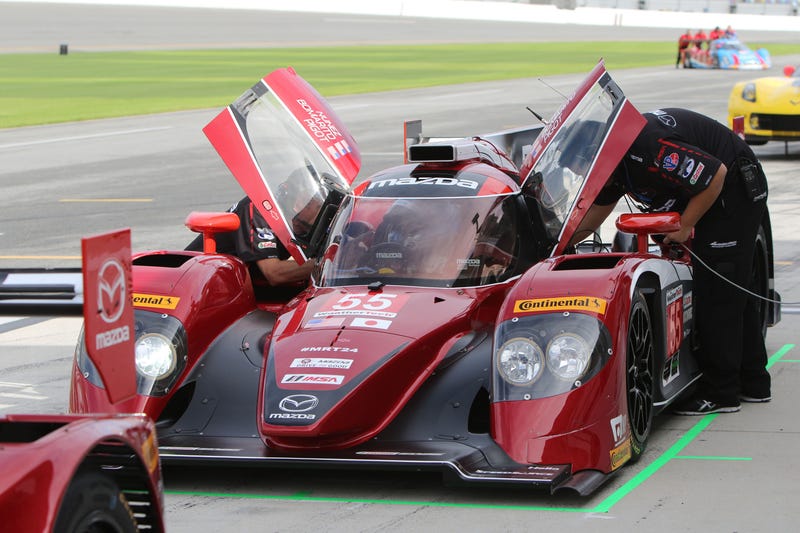
The current program started its descent into lovable wackiness in 2013 with the ultimate Jalop racing machine: a big Mazda6 sedan built powered by a Skyactiv diesel engine for Grand-Am’s GX class. Mazda wanted to pimp its zoom-zoom diesels, and we applauded it for being weird and wonderful.
Sponsored
For 2014 when Grand-Am merged to become the United Sports Car series (later renamed for sponsor WeatherTech), they stuffed the engine into a Lola prototype. The diesel engine had been slightly modified for the needs of racing, and the team worked closely with the road car side so that their work on that their development work could benefit the road-going Mazda6 as well.
LaGrone elaborated on how well they got to know the diesel prototype over the past couple years:
We ran that for two years. That was a really important development program. We did a lot of really excellent learning with that, and really showcased the fuel efficiency of the Skyactiv diesel engine. Really, looking now, it allowed us to learn the prototype chassis and that part of the package.
That prototype chassis was kept for this year, when a shift in the regulations mandated that all Prototype-class competitors run on gasoline. The switch to gasoline fuel in the newly renamed WeatherTech Sports Car Championship predated the Volkswagen dieselgate scandal, so it was something Mazda planned for well ahead of fall of last year.
Thus, the Mazda Prototype team had to accommodate a new turbocharged 2.0-liter direct injection engine. After all, the car is just a Lola LMP2 chassis that doesn’t really care what engine it has.
Advertisement
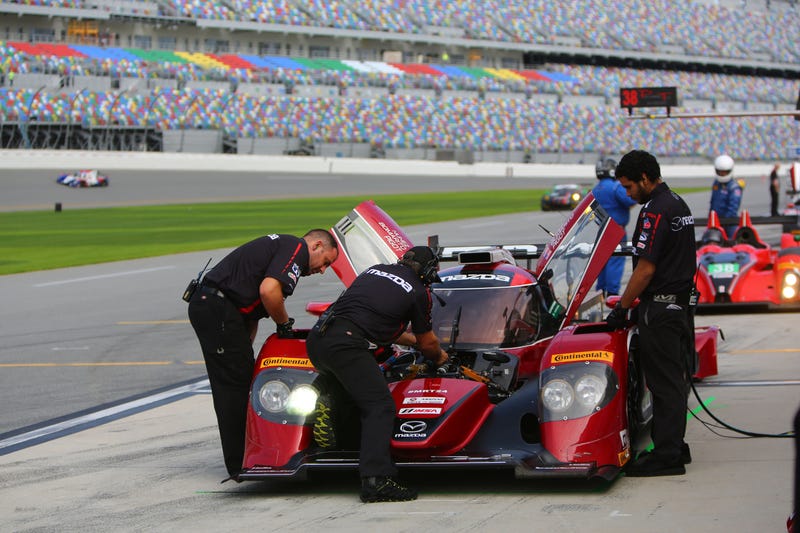
Many say that it’s the engine the car always deserved: the four-cylinder Mazda MZ-2.0T, developed with Advanced Engine Research Ltd., who also supplies the MZR-R engines in Indy Lights. The engine produces approximately 570 hp with a relatively high compression of 13.5:1. It feeds into a 4-2-1 tubular exhaust. As a result, they have a higher top speed of over 190 mph.
LaGrone explained the massive overhaul they did to get the car to work well with a brand new powerplant:
We basically, for lack of a better term, changed all of the ancillary components. … The car does not really know what engine it has, but a lot of the requirements of the engine were different. Different—you know, maybe this particular part that we had would have been sufficient, but we took the opportunity to redesign things and really optimize the package as a whole unit, which is really part of Mazda’s Skyactiv design philosophy.
LaGrone says that they’ve optimized everything they can, especially when it comes to cooling, with tweaks made to the intercooler, oil cooler and radiator. The gas engine revs much higher, so even though they have the same gearbox as the diesel car, they had to switch up the gear ratios to make it work. Other items that were tweaked include the engine’s attachment to the chassis, the fuel system and many electronics, such as the new gas-engine-compatible ECU.
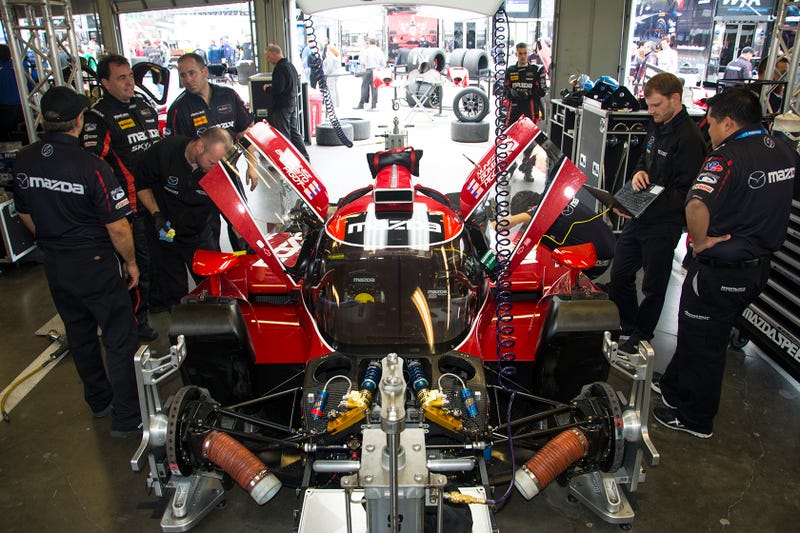
This year, it’s looking up for the Mazda team. There’s a new sense of optimism I haven’t felt from the team in a while.
“There’s definitely good vibes around this package, and we have really high hopes for this,” explained LaGrone before Daytona. He continued, “Overall, the car just works better. So, I think part of the good vibe is that this is just a really well-balanced, easy to drive package.”
LaGrone also said that the team’s overall design philosophy hasn’t changed: making things lighter, stronger and more efficient is their schtick, as it always has been. The gas-powered prototype is an evolution, if anything.
The team led early in the season-opener Rolex 24, with the No. 55 car battling back and forth for the lead. Their nine laps led at Daytona were more than more than they led for the entire 2015 season. Sadly, No. 55 pitted from the lead and couldn’t get restarted, necessitating a lengthy ECU swap. The car later went back out, but eventually retired after a valve train problem and an engine fire. It survived 11 hours and 30 minutes of racing—almost half of the race’s duration. Unfortunately, the sister No. 70 was never in contention thanks to a flywheel failure twenty minutes into the race that damaged too much for the car to be repairable.

Despite both cars eventually retiring with mechanical issues, it was an optimistic start for the new engine. If they fixed these gremlins, they would have something!
The No. 55 Mazda finished sixth at a very wet Sebring race after serving two pit lane penalties and having to come in to repair the car after going off track. No. 70 befell a similar spinny fate and finished one lap down in eighth place. Fortunately, the bulk of the Mazdas’ problems happened early, giving them ample time to work their way back up.
For this weekend’s race at Long Beach, Jonathan Bomarito in the No. 55 car was the fastest in Free Practice 1—the first time ever that Mazda led the Prototype class in a practice session.
Unfortunately, speed doesn’t make the car immune from collisions, as Tristan Nunez in the No. 55 collided with the No. 90 Visit Florida Racing Corvette Daytona Prototype in qualifying. The No. 90 car spun in the hairpin, and Nunez ran into it. He still went fifth fastest in the session. Tom Long in the No. 70 Mazda Prototype, however, qualified third with a time just 0.679 seconds off of the pole-sitting No. 5 Action Express Racing Corvette Daytona Prototype. Despite the No. 55 crash, this is the team’s best ever qualifying result.
Admittedly, the Mazda is running an older chassis by now. 2017 will bring a host of new changes to IMSA’s prototype classes, and that’s when they’re likely to overhaul the car yet again. However, in the meantime, both cars have been far and above the fastest LMP2-style prototypes at Long Beach, even contending for a podium spot at times. To say that about a program that was formerly a perennial backmarker is a massive turnaround, and nothing short of amazing.

